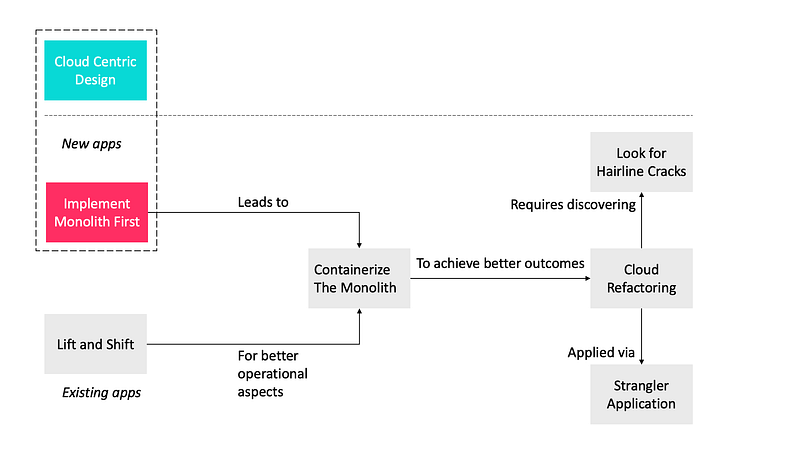# Essential Patterns for Cloud Migration: Insights and Strategies
Written on
Chapter 1: Understanding Cloud Adoption Patterns
Cloud adoption patterns encompass the most prevalent strategies organizations use to transition from conventional operations to cloud computing. These patterns encapsulate valuable lessons learned from prior experiences.
A pattern serves as a solution tailored to address a specific problem within a defined context.

Key Patterns for Cloud Migration
#### Cloud-Centric Design
Context: You have the opportunity to create a new application tailored to meet your needs.
Problem: How can you design your application to leverage the full spectrum of cloud features for optimal future-proofing and flexibility?
Solution: Adopt a cloud-centric design for your application, ensuring it operates natively within a Platform as a Service (PaaS) environment.
Cloud-native applications—those designed specifically for the cloud—follow distinct principles that differentiate them from traditional applications. These typically involve a microservices architecture, utilizing domain-driven design to break down monolithic structures. Additionally, it’s essential to adhere to DevOps principles and the twelve-factor methodology, which includes aspects like codebase management, dependency handling, and process stability.
#### Implementing Monolith First
Context: When launching a new project, speed is crucial, and microservices can introduce additional complexity.
Problem: What’s the fastest way to deploy a new application?
Solution: Start with a monolithic architecture. Transition to a microservices structure only after validating the application's complexity warrants such a shift.
Beginning with a monolith allows the development team to gain a deeper understanding of the business domain, which can be instrumental when evolving towards microservices. This transition can occur in one of two ways: either maintain a solid monolithic base while developing microservices around it or gradually transform the entire application into microservices.
#### Lift and Shift
Context: You're assessing various cloud providers and have an existing application ready for migration but lack the resources for a complete rewrite.
Problem: How can you transition your application to the cloud while making minimal changes?
Solution: Select an Infrastructure as a Service (IaaS) provider that closely resembles your original environment and perform a Lift and Shift to transfer the application to the cloud.
#### Containerizing the Monolith
Context: You are moving an existing system to the cloud.
Problem: What’s the best method for a swift migration while retaining the flexibility for on-premises development?
Solution: Start by containerizing your monolithic application. This allows you to run it in Docker on-premises while also enabling a gradual transition to various public and private cloud options.
#### Cloud Refactoring
Context: You wish to migrate an existing application to the cloud.
Problem: How can you adapt the application for cloud deployment without a complete rewrite?
Solution: Engage in cloud refactoring to adjust the most problematic dependencies, paving the way for deployment as PaaS components. Over time, you can refactor additional components to embrace more cloud-native technologies.
#### Identifying Refactoring Opportunities
Context: You are analyzing an existing application for cloud readiness.
Problem: How can you pinpoint areas suitable for microservice refactoring?
Solution: Look for "Hairline Cracks," which indicate segments of the monolithic application that are ripe for decomposition into microservices.
The Strangler Application Approach

Context: You are dealing with a legacy monolith that functions as a web application.
Problem: What approach allows for gradual migration of legacy applications to the cloud without requiring a complete rewrite?
Solution: Employ the "Strangler Application" model, which enables you to redirect requests from the legacy system to a new implementation incrementally. This method allows for new features to be added gradually, transitioning functionality from the old monolith to microservices without the risk of overwhelming complexity.
The essence of this strategy lies in progressively delegating new features to microservices while maintaining core functionalities within the legacy application, thus preventing it from becoming larger and less manageable.
References:
Chapter 2: Architectural Patterns for the Cloud
Learn about crucial architectural patterns that guide cloud adoption, emphasizing design strategies that foster resilient applications.
The first video titled "Architectural Patterns for the Cloud" by Mahesh Krishnan delves into essential strategies for designing applications in the cloud, focusing on best practices and lessons learned.
Chapter 3: Resilient Application Design Patterns
Discover effective design patterns that enhance application resilience in cloud environments.
The second video, "AWS Developer Webinar Series: Five Design Patterns to Build More Resilient Applications," outlines key patterns that developers can use to create robust applications capable of thriving in the cloud.